When growing horticultural crops in northern areas with harsh winters, it is important to pay special attention to providing reliable shelter from the cold. Therefore, experienced gardeners can explain to a beginner how to cover grapes for the winter in Siberia to prevent its freezing. Protecting plants from the effects of frost is one of the primary agricultural practices.
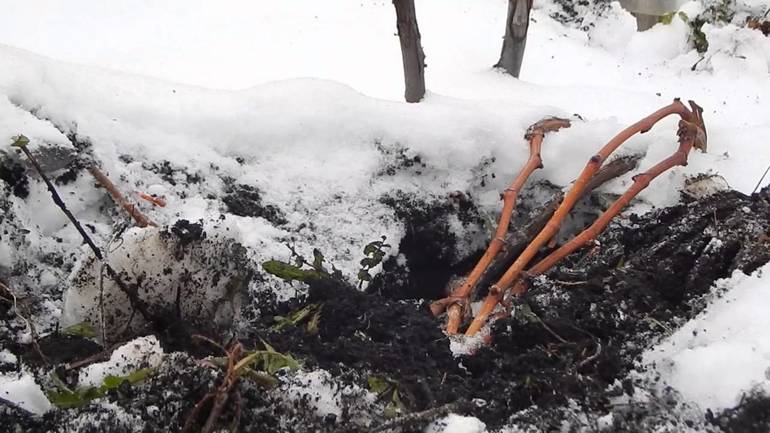
Content
The importance of a proper fit
The key to successful sheltering of grapes in Siberia is the correct planting, which ensures the formation of strong roots. If the root system is not sufficiently hardened, most likely, the first severe frost will lead to the death of the culture.
Since ancient times, Siberians have grown vines by special technology. Cultivation techniques have been developed for many years, and their effectiveness has been verified by numerous experiments.
When choosing a landing site, it is important to make sure that It meets the following requirements:
- Good lighting conditions.
- Lack of high humidity.
- No shading.
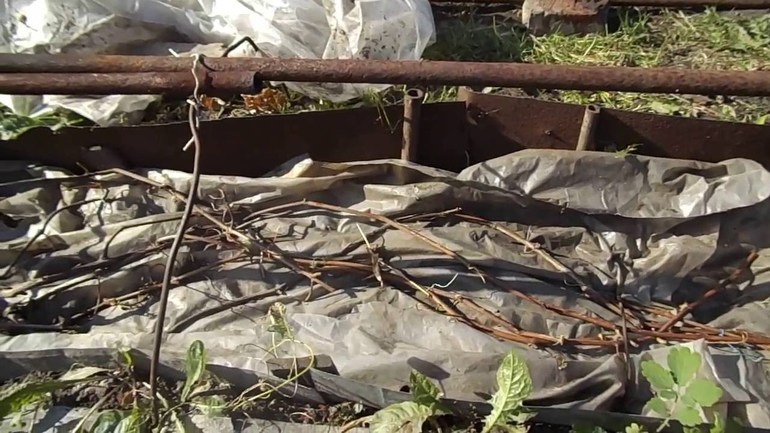
On the south side of the building, the vine can be planted only in those cases if the gardener can constantly monitor its condition in the winter.
If this is not possible, landing near the buildings is pointless, since the height of the snow cover in such a place is quite insignificant. When choosing a suitable crop cultivation technique, it is recommended to give priority to proven methods. Classic options used by gardeners from the northern latitudes are useless here. It is necessary to apply a more effective solution - an in-depth way of landing.
 You may be interested in:
You may be interested in:The key task of each grower is to grow strong roots and provide reliable protection of the plant from freezing. Due to the need to cover the vine for periods of severe frost, it is better to plant it in a pre-prepared trench or wooden box. The task of such a deepening is to isolate the culture from the cold. Its parameters are as follows:
- Width - 40−50 cm.
- Depth - 20-30 cm.
When using boxes, they do not need to be buried in the ground. It is enough to warm the walls with a layer of clay - in this case the vine will be reliably protected from the cold, and the vegetation process will begin 10-12 days earlier.
The subtleties of care
Siberian grapevines must undergo comprehensive preparation for the cold. It consists in limited nutrition and minimal watering, so that the plant can adapt to harsh conditions. Otherwise, the local climate will be disastrous for grapes.
Proper fruit care includes such stages:
- Formative Procedures and fruit load control.
- Application of foliar and soil fertilizers.
- Trimming eventsstepsoning.
- Protective work.
- Shelter for the winter.
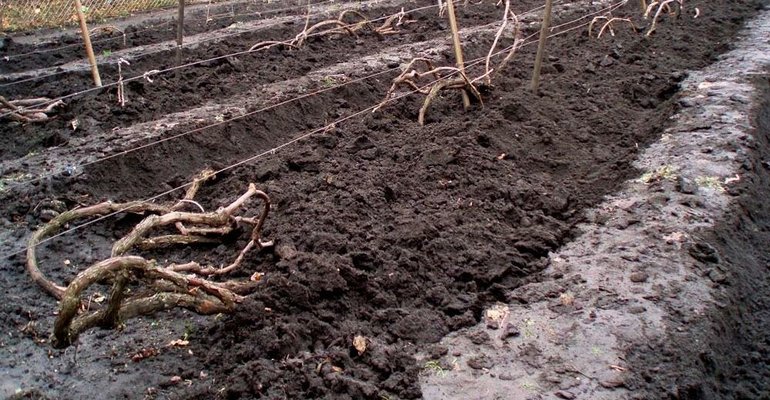
All other vegetative processes occur naturally.At the age of three years, the sapling does not need additional fertilizing, because it needs the fertilizers that were introduced into the pit during its preparation. This is often a large dose of humus. From the fourth year of life, an additional bucket of humus or manure is placed under the bush.
Feeding held no more than once a day. It is important not to overfeed the vine, otherwise it will get used to such a feast and will cease to cope with a prolonged hunger strike. In mid-spring or early May, about 10 kg of fresh manure are poured under each bush. Fertilizer is fed directly under the vine, without being buried in the ground. In this case, you need to make sure that it does not get to the roots.
In order to stimulate the development of powerful immunity that can withstand severe frosts, foliar top dressings must be applied under the vine bushes. Before the flowering season begins, the bush is treated with a solution of boric acid, and at the end - with zinc sulfate. Also, as a good foliar top dressing, Kemir's composition and magnesium sulfate can be used.
Trimming events
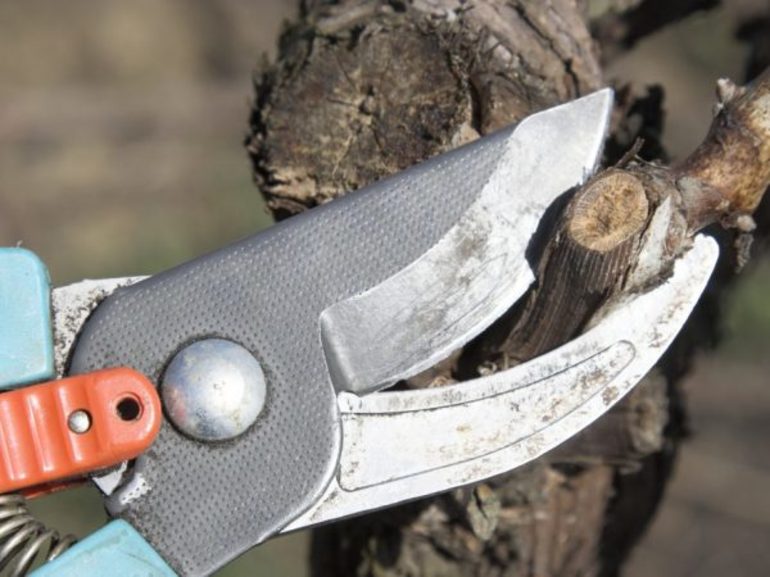
With the advent of August, the natural processes of growth in the branches of the vine begin to slow down. Also at this time, its top is completely straightened out, which indicates the need for pruning young shoots that cannot finally form before the onset of cold weather. During autumn pruning, you should get rid of spinning tops and stepsons.
Autumn pruning of grapes is carried out according to the Guyot method, which involves the formation of a squat stem and short sleeves. The number of the latter depends on varietal characteristics. On a powerful bush there should be no more than 4-8 sleeves, and on medium-sized shrubs - no more than two.
Trimming should begin after the first serious frost. It is also important to do this no later than two weeks after the leaves fall.
The procedure itself is conditionally divided into two stages. First of all, it is necessary to get rid of the frigid and unripe sleeves, stepsons and other shoots. When pruning a young bush, leave no more than three healthy shoots, for six-year-olds - 4 sleeves, and for 7-year-olds and older - from 6 sleeves.
The next stage is the formation of the fruit vine (shooter). To do this, leave one arrow on the sleeve and cut it to 4 kidneys. In this case, stepsons are shortened to one kidney.
If the sleeve has formed on an old tree and strong fruit shoots have started from it, no more than two arrows can be left. When performing pruning, one should adhere to such principles: arrows can grow from different buds and be at different levels in relation to the root system.
Cutting work in the autumn period involves the removal of unripe vines with a white middle, which can be seen when the vine is cut. Branches with a green middle are ripe and prepared for winter.
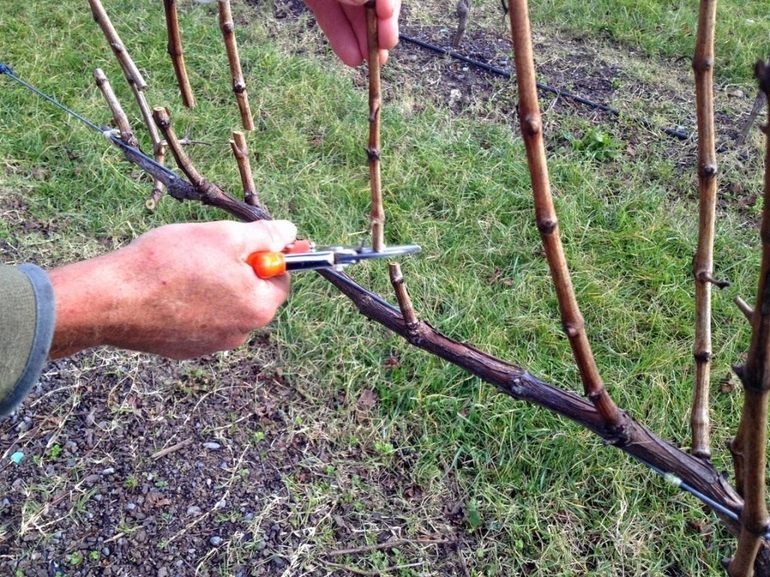
Siberian grapevine varieties are characterized by excellent resistance to all kinds of viruses and diseases. This is due to a simple fact - most infections are not able to survive in severe frosts. The use of toxic drugs and chemicals to protect against diseases is simply not necessary. Therefore, the fruits of the northern vine are also famous for their full ecological purity.
Effective shelter
When choosing the optimal timing when to cover the grapes in Siberia, you need to consider several recommendations and rules. This procedure consists of several stages:
- Removing vines from trellises and pinning to the ground.
- Treatment with fungicidal preparations.
- Arrangement of shelter before the start of frost.
- The ultimate shelter.
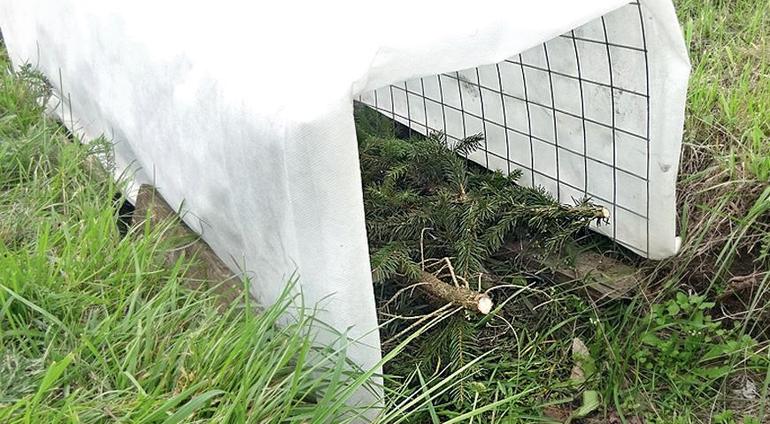
Look for some more sophisticated methods of protecting the culture from the cold is not necessary. Fruit varieties grown in Siberia are famous for their excellent immunity, so they are not afraid of even the most serious colds. With minimal effort, you can provide excellent shelter that will withstand any frost.
The vine is removed from the trellis immediately after the leaves fall. By the way, all fallen leaves need to be removed from the vineyard and burned, because it can succumb to rot and become a comfortable environment for the development of dangerous bacteria and viruses. When performing this task, care must be taken, otherwise it may damage the lashes.
Some gardeners recommend equipping roofing insulation at the bottom of the recess. A good analogue for such a material is a plastic film. The presence of an additional warming layer will prevent the vine from contacting with moisture, which gradually accumulates at the bottom of the trench.
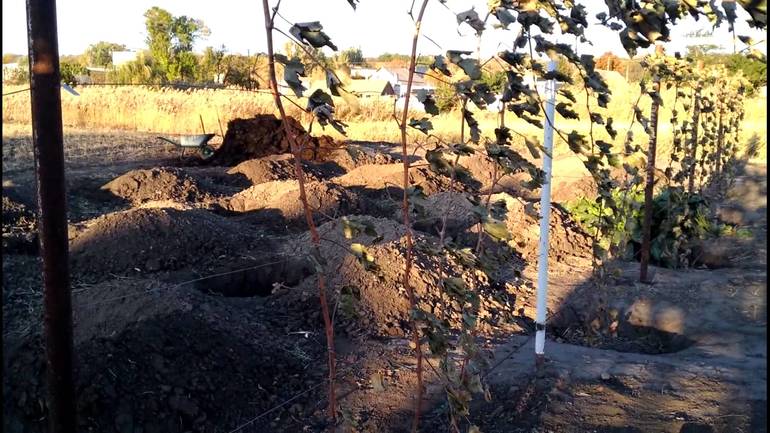
The methods of sheltering the vines in the northern regions may vary, depending on the current temperature and climatic conditions. But the general principles and rules of such work remain similar.
The trunk circle is insulated with a thick layer of earth at a height of 10−20 cm. The vine itself is bundled and attached to the ground with metal staples. They are placed at a height of 10−20 cm above ground level.
Additional processing
To effectively protect the vine from the cold, it must be additionally treated with a 3-5% solution of iron sulfate. This procedure must be completed immediately after laying the crop on the ground, always in dry weather. Also, the plant is treated with a 5-7% solution of iron sulfate, paying attention to all parts of the shelter: from boards, to slate and roofing material.
Metal supports should be placed on top of the culture at a level of 30–35 cm. After this, the trench is covered with polyethylene, roofing material and a film. The sides can not be closed until the onset of severe frost from -10 degrees Celsius. With the right choice of the depth of the trench, the grapes will be reliably protected from the most aggressive climatic influences. In addition, its root system will not be affected by frost or dangerous infections.
 You may be interested in:
You may be interested in:When using a metal box instead of deepening in the ground above the grapes, it is necessary to equip a special fence made of wooden slats or a welded mesh with increased rigidity. This design is additionally insulated with spanbond or agrosilo, which are folded in two layers. You can also use mats made of straw and reeds. To protect the shelter from moisture penetration, a waterproofing layer should be fixed on top. As a material for waterproofing use a film, slate, roofing felt or roofing.
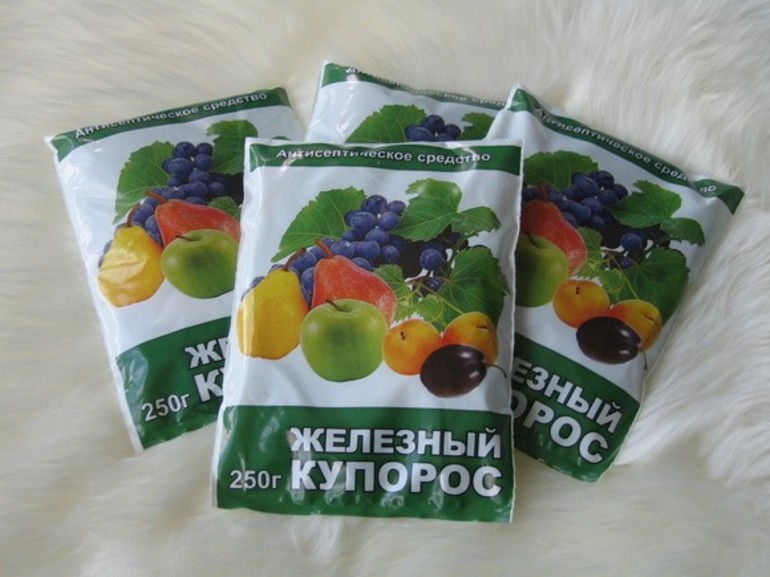
In early November, the trench needs to be additionally insulated, covering it with earth with a layer of 10 cm. After the snow falls, at least 40 cm of this fluffy cover should be warmed over the shelter. Also near the vine itself it will be useful to equip a snow-retaining structure.
It is not difficult to build a good shelter for growing grapes in Siberia. Such a task does not take much time and effort, especially if you prepare the necessary materials and tools in advance. As for the time when it is better to start such a procedure, this is the beginning of leaf fall, as well as the establishment of a stable temperature regime within +5 degrees Celsius. The final stage of warming occurs with constant frost of -5 degrees.
The best varieties of the northern regions
The cultivation of vines in the northern regions became possible after lengthy selection work, through which Amur and American varieties were combined. Distinctive properties of such hybrids are:- Resistance to severe frosts.
- Fast build-up of green mass.
- The ability to withstand intense temperature shocks.
By the way, some breeding hybrids are so cold-resistant that their buds may not freeze out even under the influence of frosts down to -40 degrees Celsius. The root system can withstand up to -20 degrees.
Some varieties are not afraid of maintenance on scarce soils with the absence of intensive top dressing, regular spraying or shelter. Of the shortcomings of such varieties, only low taste properties are distinguished, but breeders are working hard to eliminate this problem, so every year new unique varieties appear in the world that deserve special attention.
Among the most popular northern varieties are:
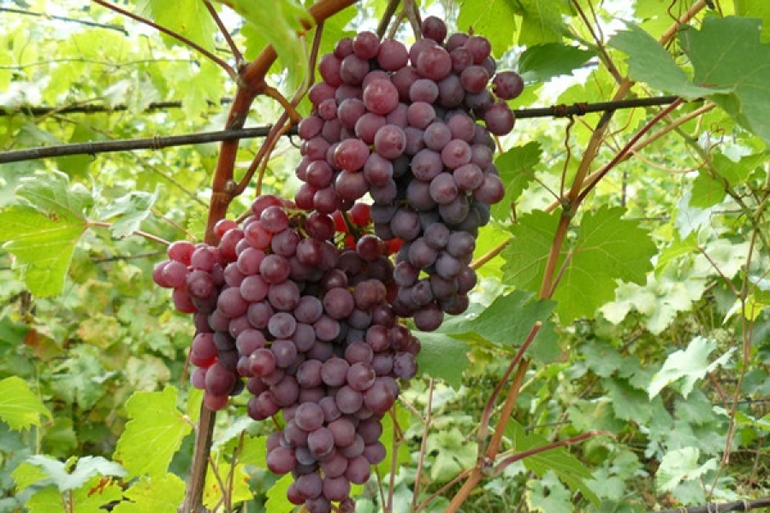
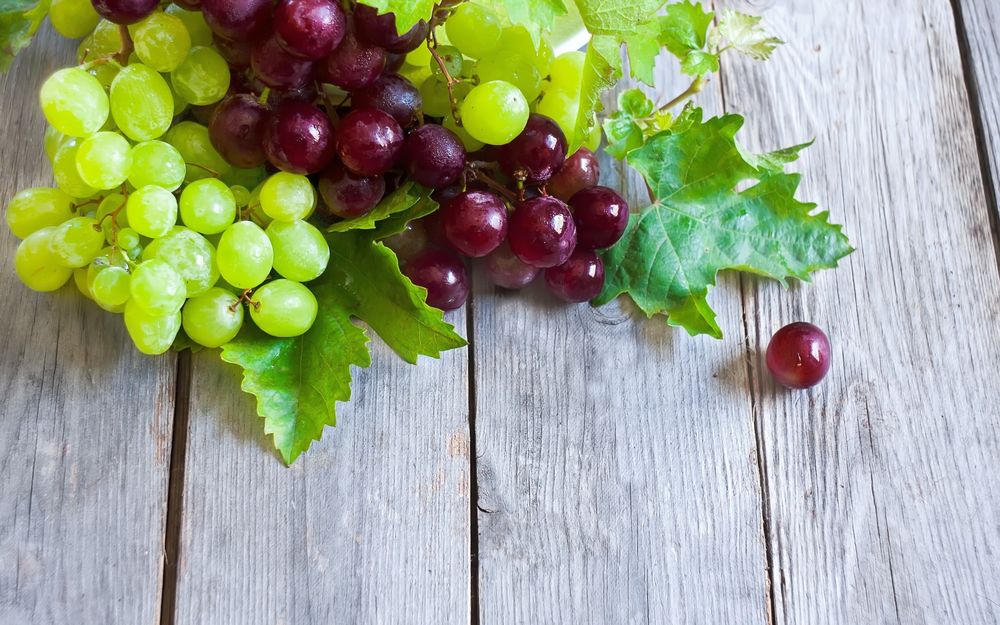 You may be interested in:
You may be interested in:- Russian early dining room. One adult bush can produce up to 25 kg of fresh berries. The variety is not afraid of infections and viruses.
- Pearls Saba, table. It is characterized by a sweet taste of berries.
- Delight. One bunch can weigh up to 2 kg. The variety is not afraid of diseases and can withstand severe frosts.
- Riddle. It is considered the most popular variety, which is in demand because of its reliability and cold resistance.




 Non-covering winter-hardy grape varieties for Moscow region
Non-covering winter-hardy grape varieties for Moscow region How to keep the vine in winter
How to keep the vine in winter When can I transfer grapes to another place in the fall
When can I transfer grapes to another place in the fall How to cover and prepare grapes for the winter in the suburbs
How to cover and prepare grapes for the winter in the suburbs